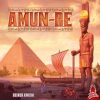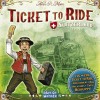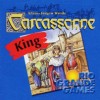
Legendary ST
gamer level 3
802 xp
802 xp
followers
2
2
Use my invite URL to register (this will give me kudos)
https://boardgaming.com/register/?invited_by=skaggstyler
profile badges

...
...
...
recent achievements

I'm Gettin' the Hang of It
Claim that you have played a game today by clicking the "Played Today!" button on a game page 10 times.
Claim that you have played a game today by clicking the "Played Today!" button on a game page 10 times.

Supporter
Give 10 hearts (loyalty points) to a single game
Give 10 hearts (loyalty points) to a single game

Gamer - Level 3
Earn Gamer XP to level up!
Earn Gamer XP to level up!

Observer
Follow a total of 10 other gamers.
Follow a total of 10 other gamers.
Player Stats
Critic (lvl 1)
245 xp
245 xp
Explorer (lvl 1)
131 xp
131 xp
Professor (lvl 0)
95 xp
95 xp
Reporter (lvl 1)
132 xp
132 xp
About Me
I like strategy games - euro, themed, card based...whatever. Most recent purchase was tigris & euphrates, merchants & marauders, troyes, innovation, steam, and carcassonne big box 3. I like arkham horror, 7 wonders, race for the galaxy, caylus, agricola, puerto rico, age of empires 3: the board game, age of industry, brass, le havre, pandemic, and automobile. ALWAYS looking for new stuff. I'm a sucker for expansions On my radar is ora et labora, pillars or the earth, world without end, the resistance, acquire, intrigue, neuroshima hex. Interested in learning more about london. Have but still haven't played tyoyes, tigris & euphrates, and sherlock holmes: consulting detective.











































Amun Re
Amun Re is a game for 3-5 players involving strategic planning for later rounds, evaluating different aspects for value to opponents and oneself, and bidding accordingly. Generally it will take 45 -75 minutes, depending on number and experience of players. First I will do a game overview, then a round overview, then will speak a little on my thoughts.
GAME OVERVIEW
The map displays a section of ancient Egypt along the Nile that contains 15 provinces, each with unique strengths and weaknesses. During the game there are two halves – during the first half of the game each player will build up civilizations and pyramids on 3 provinces each. This represents the “old kingdom” time period of ancient Egypt. After the first half of the game, he players are scored on their work and everything is wiped away…literally. Anything a player adds to a space will be removed from the board, with the exception of pyramids and their building stones.
Next begins the second half of the game, representing the “new kingdom.” Players essentially start over and do the same thing, which is less repetitive than it would seem as there is one significant difference: in games with less than the full 5 players, the provinces available to the players at the beginning of the “new kingdom” may NOT be the same ones they could choose from the first time around, and there is no guarantee they will claim the provinces they owned in the first half. In the second half you start with whatever money you made in the first half of the game, so not everyone is on the same level. Many provinces will already have pyramids on them, making them significantly more valuable and sought after, as well as ramping up the level of competition. After the buildup of the “new kingdom”, the game ends and is scored.
ROUND OVERVIEW:
Bidding
Players start the game with 20 gold (in the form of cards), as well as a (-3) gold card (explained later) and a pyramid building power card. The first player takes the starting player token (a cardboard pharaoh), and the cardboard temple sacrifice token is put on the sacrifice track at the top of the board. The board is comprised of said temple sacrifice track at the top, the Nile running straight down the center of the board, and the 15 provinces (7 on one and 8 on the other side of the Nile.) With the province cards ready nearby, the game is ready to begin.
After the province cards are shuffled, deal out a number equal to the number of players (in a 4 player game, deal out 4) into a common area. These are the provinces available this round. Each card has a “bidding track” with set, increasing bid levels (starting at zero) running around it. The bidding begins with the first player, who places his colored marker on the province of his choice at his selected bid level.
This continues in clockwise order with each player selecting to bid over the player(s) on a current card or to begin bidding on a card that has not yet been bid on. At the end of one round of bidding, if all player markers are on different cards, bidding ends and players pay for their provinces according to their bids. If this condition is not satisfied, bidding continues in turn order, with each player who had been outbid now choosing to bid again. Players bidding again can NOT place their marker to outbid the player who outbid them (they cannot re-bid on the province they were outbid on). When all players have claimed provinces (the last province can always be claimed for free), they each place a token of their color on the board in their new province.
Actions
The next phase is the action phase. In turn order, players purchases and places farmers, buy (and may use) power cards, and purchase building stones/pyramids (three building stones can be used to form one pyramid). The first of each type of item (stone, card, farmer) costs 1 gold, with each successive item costing 1 addition gold than the last unit ( 3 farmers could cost 6: 1 for the first farmer, 2 for the second, and 3 for the third) In this way, 3 farmers, 2 cards, and 4 stones would cost the player 19: 1+2+3+4 = 10 for the stones, 1+2 = 3 for the cards, and 1+2+3 = 6 for the farmers.
The chosen provinces determine to some extent what each player may purchase in a given action round. Each province will contain (or lack) any number of spaces in which a farmer may be placed and a number of power cards (or none), among other things. These two aspects of the provinces are important now: the number of farmer spaces available in a province determines the maximum number of farmers a player may purchase and have in that space, while the number of power card icons in a space allows you to buy only that many power cards per turn. A given space can hold any number of pyramids and/or building stones, the only limit is what a player may afford.
In addition to the power card icons and the farms, provinces also MAY contain a combination of temples (which give a variable number of points at the end of the old and new kingdoms, set income (denoted by a gold coin with a number inside), drought only income (denoted by gold with a picture on a camel nearby), and in some cases contains free items the winning bidder immediately receives on claiming a province, such as gold, power card(s), or building stone(s).
It should be noted that players do not have any ability to buy power cards apart from the privilege given by provinces. Also, the power card purchase privilege does not stack over the course of a game a player who claims a first province that allows the purchase of 3 power cards, and then claims a second province card next round that gives the ability to purchase 2 province cards STILL possesses the ability to purchase 3 power cards. The privileges do not stack. If, during the last round of the old kingdom the player acquires a province that allows for the purchase of 4 power cards, he/she can now purchase only 4 power cards in the action phase that round.
Sacrifice
After the Action phase comes the Sacrifice phase. The collective amount of sacrifice determines how fertile the land is this round. Players choose secretly and simultaneously what amount of sacrifice they wish to contribute. Players (as noted at the beginning) are provided with a (-3) gold card. They may choose to sacrifice the (-3) card or any number of gold from their hand (the -3 card is played alone, and represents stealing from the sacrifice). Players place their sacrifices face down in front of them, holding their hand over them so other players cannot see the number of cards chosen. Players simultaneously reveal their cards and tally up the sacrifice. The temple sacrifice track at the top is divided into 4 sections, each representing a different level of sacrifice. Level 1=2 or less, Level 2=3-12, Level3=13-22, Level 4=23+.
Level 1 represents extreme drought, while level 4 represents plenty. On the track levels 1 and 2 have a picture of a camel on them, while levels 3 and 4 do not. The total number of gold (add all sacrifice gold, subtract each (-3) card presented = total sacrifice. Let’s assume that in a 4 player game, player 1 sacrifices 5, player 2=3, player 3=6, and player 4=(-3). 5+3+6 = 14 minus the (-3) = 11. Move the temple to sacrifice level 2.
The player with the highest sacrifice claims 3 rewards in any combination of building stones, farmers (assuming their province’s farms are not full), or power cards (which may be claimed regardless of province limits). The second player claims 2 rewards, and the rest of the players who did not play the (-3) claim one reward. Ties for position are resolved clockwise from the starting player. Finally, any player(s) who played a (-3) collect 3 gold from the bank.
Harvest
In the Harvest phase players take gold for each of their farmers. All farmers produce 1 gold each per level of sacrifice. With the sacrifice at 2, each farmer produces 2 gold for its owner. Provinces with no farmers and only a numbered symbol of gold on them provide that number to their owner, such as (8). Provinces with a gold symbol with a number in it, such as a (7) with a camel next to it only produce their gold in drought years (sacrifice levels 1-2) so in this example those players would claim their gold…this time.
Scoring (only after old and new kingdoms)
Players play 3 rounds per kingdom, claiming an additional province each round. After these 3 rounds the old kingdom is scored. The new kingdom follows with 3 rounds of its own, and then it is scored as well. Players are scored first based on the number of pyramids (1 point each). Next players are scored based on sets of pyramids, defined as one pyramid on each of your provinces (3 points per set). So, a player with two provinces containing 2 pyramids each and their third province containing 3 pyramids would get 7 points for the pyramids (2+2+3) and 6 extra points for her sets (3+3).
The player with the largest single pyramid on per side of the river (the largest pyramid on the east side, and then the largest pyramid on the west side) get 5 points each. Ties are resolved by the pyramid with more building stones and further ties gain equal points. Players add in any bonus power cards they may have collected. Some examples are: having all your provinces on the east or west side of the Nile, having all your provinces in the north or south, and having at least 9 farmers between your 3 provinces. Each bonus card which you own and whose requirements you fulfill will gain you 3 points each.
After the scoring of the New kingdom the game ends. The player with the most points is the winner, with ties being broken by most pyramids and further ties broken by most building stones. If there is still a tie, the tied players win.
FINAL THOUGHTS
I really feel like Amun Re does well with its theme. There are some mechanics that really don’t make sense, such as the sacrifice, without the theme. The artwork is good, and while it does add to the theme, most of it is really there purposefully, such as the camel being present on the temple track on both the first and second sacrifice levels to remind players only to claim the province’s camel gold in drought years.
Neither the power cards nor the board have any text on them (other than province names) so once players know what the pictures mean (easily done in one game) and the rules, there is practically ZERO in-game text dependency. The pictures are all very descriptive, as well, more easily lending themselves to the fact that there isn’t text. I really don’t feel like this is one of those games that suffers from a certain number of players. With 5 players there potentially will be more competition, but with fewer you may not see the same provinces between the old and new kingdoms.
There does seem to be a distinct advantage of experienced over new players. There isn’t a bad learning curve for the mechanics at all, but most new players will probably do pretty badly the first time around just with strategy. I certainly did badly my first time through, despite having an experienced player who I could model play after. After the first couple games the strategy really evens out and things become competitive. Overall, Amun Re has good theme, good mechanics that go well with the theme, and good depth and strategy for its length.